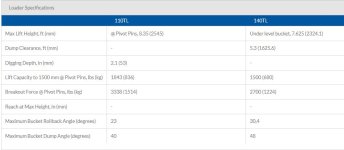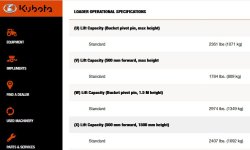CMV
Platinum Member
Neal (Messick's) recently did a video on it describing how different companies advertise their loader specs differently and how that can make X look better than Y on paper. Would be a good one to watch.
Anyway, yeah, sounds like you got it....what are they measuring and from where to get that # on the spec sheet. If not apples:apples, that # doesn't really tell you which one will/won't do your task in the real world.
Geometry plays a part too - in general a loader that can't go as high or reach out as far can move more weight. It's a tradeoff. Best thing you can do is if you know you need to lift a pallet of widgets to 6' height or move round bales of X diameter is to test that out when shopping. Either the machine can do what you need or it cannot regardless of what the marketing guys had printed in brochure.
Anyway, yeah, sounds like you got it....what are they measuring and from where to get that # on the spec sheet. If not apples:apples, that # doesn't really tell you which one will/won't do your task in the real world.
Geometry plays a part too - in general a loader that can't go as high or reach out as far can move more weight. It's a tradeoff. Best thing you can do is if you know you need to lift a pallet of widgets to 6' height or move round bales of X diameter is to test that out when shopping. Either the machine can do what you need or it cannot regardless of what the marketing guys had printed in brochure.


